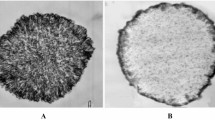Summary
Potentiometric titrations and electrophoretic mobility measurements were made on carboxylated polyphthalamide microcapsules prepared by the interfacial polycondensation method.
The values of surface potential and zeta potential of the microcapsules were calculated by using a theoretical potentiometric equation and the simple Smoluchowski equation, respectively.
The ionic strength of the medium was found to have no effect on the conformation of the polymer chains of the microcapsules.
The negative surface potential obtained from potentiometric titration data rose first with increasing pH of the medium and then tended to level off as the pH approached 7 while the zeta potential as evaluated from electrophoresis data was found to change until the pH attained a value of 10.
The cause for this difference in pH change between the surface potential and the zeta potential of the microcapsules was ascribed to the reason that potentiometric titration does not permit the detection of terminal amino groups of the polymer chains constituting the microcapsules, which are far smaller in number than the carboxyl groups, while electrophoresis can detect the presence of the terminal amino groups.
Zusammenfassung
Mit Poly(phthaloyl-l-lysin)-Mikrokapseln wurden potentiometrische Titrationen and elektrophoretische Messungen durchgeführt. Die Größen des Oberflächenpotentials and des Zeta-Potentials der Mikrokapseln wurden unter Verwendung einer theoretischen potentiometrischen Gleichung bzw. der Smoluchowskischen Gleichung berechnet. Es stellte sich heraus, daß die Ionenstärke keinen Einfluß auf die Konformation der Polymerketten der Mikrokapseln ausübt. Das negative Oberflächenpotential, welches aus den potentiometrischen Titrationsdaten erhalten wird, steigt mit dem pH-Wert des Medium bis pH = 7, während das aus den Elektrophoresedaten abgeleitete negative Zeta-Potential mit dem pH-Wert bis pH = 10 zunimmt.
Dieser Unterschied zwischen dem Oberflächenpotential und dem Zeta-Potential der Mikrokapseln bei pH-Änderung wird dadurch erklärt, daß bei der potentiometrischen Titration terminale Aminogruppen in den Polymerketten nicht gefunden werden, während die Elektrophorese auf die Anwesenheit terminaler Aminogruppen anspricht.
Similar content being viewed by others
References
Takahashi, K., T. Kondo, Colloid & Polymer Sci., in press.255, 357 (1977).
Arakawa, M., T. Kondo, B. Tamamushi, Biorheology12, 57 (1975).
Jones, M. N., Biological Interfaces (Elsevier Scientific Publishing Co., Amsterdam 1975).
Author information
Authors and Affiliations
Additional information
With 4 figures
Rights and permissions
About this article
Cite this article
Takahashi, K., Kondo, T. Studies on microcapsules. Colloid & Polymer Sci 257, 273–276 (1979). https://doi.org/10.1007/BF01382369
Received:
Issue Date:
DOI: https://doi.org/10.1007/BF01382369



